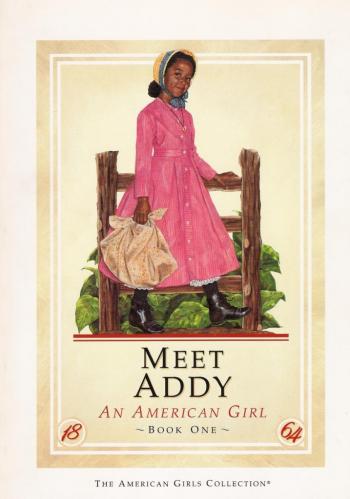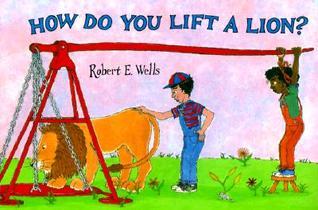
scrounge: /skrounj/ informal verb: to actively seek [books] from any available source
During my later elementary years, I really enjoyed reading the historical book series of The American Girls Collection, produced by Pleasant Company. As an adult, there are some I like more than others now, but Addy, written by Connie Rose Porter, is still my favorite. These series give girls (and boys too!) the opportunity to learn about history through characters close to their own age. The original series all follow the same six-book formula, and though the main characters are all growing up in different time periods, they all display courage and hope in various ways.
Each book contains many realistic illustrations, and a "Looking Back" section after the story that includes photographs and drawings, to give some more historical context to the setting and events described.

Meet Addy:
In the first Addy book, we are introduced to Addy, a nine-year-old girl who is a slave on a plantation near the end of the Civil War. But in the very first chapter, Addy lies awake at night and listens to her parents talk about freedom -- they plan to run away. But before they get the chance, Addy's father and brother are sold. Addy's mother makes the difficult decision to run away anyway, and leave her one-year-old baby behind with Addy's aunt and uncle, hoping that the family will all meet up again in Philadelphia someday.
Reading this as an adult/parent has a whole different dimension to it. While this series obviously does not even begin to touch on all the horrors of slavery, reading about the punishments and family separations still had an effect on me as a child, and this story made it seem much more real than a history textbook could have.
Looking Back: This section gives a brief history of slavery in the US, as well as the underground railroad and Harriet Tubman, and the beginnings of the Civil War.
Addy Learns a Lesson:
This story is about Addy's introduction to school, and we get to see her navigate the difficulties of getting an education, and of friendship. Addy and her mother arrive safely in Philadelphia, but have almost nothing. They find help and hospitality at a church, and are soon able to earn a living, though making ends meet is difficult. But Addy is determined to learn how to read, and her determination begins to pay off. In addition to learning to read, she learns about what is most important in her friendships.
Looking Back: This covers the difficulties that African-Americans had in obtaining an education during this time (and previously), and the formation of some of the earlier schools.
Addy's Surprise:
Addy and her mother are working very hard, but they are still having a hard time affording basic necessities. Still, as Christmas arrives, they both want to find ways to surprise each other. Even in the midst of their difficulties, Addy is faced with the realization that there are still so many others that are worse off than her and her mother, and both she and her mother do their best to help with what little they have. At the end, Addy recieves a wonderful Christmas surprise as one of her family members reunites with her and her mother again.
Looking Back: Holidays were much simpler in this era anyway, but during the Civil War, most families could not afford "extras." Still, many found ways to make their Christmas celebrations meaningful and festive. This section also touches on the celebration of Juneteenth, as well as the later introduction of Kwanzaa.
Happy Birthday, Addy!:
In this story, Addy meets an elderly woman named M'dear, who is blind. Despite the fact that she can't see, M'dear is able to perceive more than she appears to. Since Addy was born into slavery, she doesn't know what day she was born on -- only that she was born in the spring. M'dear encourages her to "claim" a birth date -- when she finds a day that feels right to her.
Addy continues to learn and hope and work at her education, but the streets of Philadelphia sometimes teach her some ugly things -- that she and others like her can be freely discriminated against just because of the color of their skin. Still, the story ends on a positive note, with hope that someday things will get better.
Looking Back: This section covers certain lifestyle issues of the time period: birth, children's games, education, jobs, and the way the Civil War affected families.
Addy Saves the Day:
Addy and her family are working hard to earn extra money, still holding out hope that their remaining family members will be found soon. Meanwhile, their church puts on a fair to raise money to help wounded soldiers, widows, and separated families. Addy and her friends choose to make spool puppets and put on a puppet show. But not all of her friends are easy to work with. The fair goes well, but when something goes wrong, Addy chooses to take action. At the end, she gets a wonderful surprise.
Looking Back: This section talks about city parks and other public recreation during this era, and about things families did during their leisure time.
Changes for Addy:
The Walker family has been steadfastly searching for the rest of their remaining family members. Addy has been writing letters and not hearing anything back, which is discouragaing, but she never gives up hope. Then one day, she receives an answer, and is sure that very soon, their family will be whole again. She is mostly right, but also has to suffer the pain of loss, as so many other families do.
Addy's experience is also contrasted with her friend Sarah's, which was unfortunately common. While Addy makes good progress with her education and hopes to be a teacher someday, she is saddened when her friend Sarah has to drop out of school in order to earn enough money for her family to pay their rent. In the midst of the hope and determination, it is important to see this side of things too, that some people, as Sarah's mother puts it, "got to eat today and pay for this here room tomorrow. We can't be dreaming about someday."
The story ends with Addy reading the Emancipation Proclamation at her church.
Looking Back: After the Civil War, Reconstruction brought many advancements for African-Americans, but not all of it lasted -- the South soon instituted "black codes," and made segregation worse. This section concludes with an overview of the Civil Rights movement, up through the life of Martin Luther King Jr.
As much as I like this series, it is still worth pointing out to children that Addy is fortunate in many ways: she is able to stay in school and obtain an education, and she is able to at least discover the fate of all of her missing family members, which was not the case for many children who were in a similar situation.
Scrounged From: A birthday present from my childhood
This is a fun and informative series of books, written and illustrated by Robert E. Wells, that helps introduce some basic science concepts to children. They are geared mainly toward pre-kindergarten through third grade, but they can be enjoyed by any age.

Our favorite of the ones we've read is How Do You Lift a Lion? which introduces simple machines such as the lever, wheel, and pulley. The illustrations are clear and clever, and show how a lion could be lifted if you had enough leverage. We are also shown how to pull a panda on a pallet, and how it could be possible to deliver a big basket of bananas to a baboon birthday party using pulleys.
Is a Blue Whale the Biggest Thing There Is? is another entry in the series. Here we are shown progressively bigger things from whales to earth to stars, until we get to the size (or what is known of it) of the whole universe! You definitely feel small after reading this book, and the illlustrations are very amusing at times (such as a crate of "sun-sized oranges" to demonstrate how our sun compares in size to a red supergiant).
What's Smaller Than a Pygmy Shrew? covers the same idea, but getting progressively smaller, from a shrew to a ladybug to protozoa and protons. This one may be harder to wrap one's mind around, but does a great job of helping us to visualize the idea that there is a whole kingdom of living organisms that are too small for our eyes to see.
We also enjoy What's Faster Than a Speeding Cheetah? which shows us many things that are faster than a cheetah, such as a peregrine falcon, a rocket, and a meteoroid.
These are the only titles we've read so far, but there are several others that sound just as interesting, such as Why Do Elephants Need the Sun?


